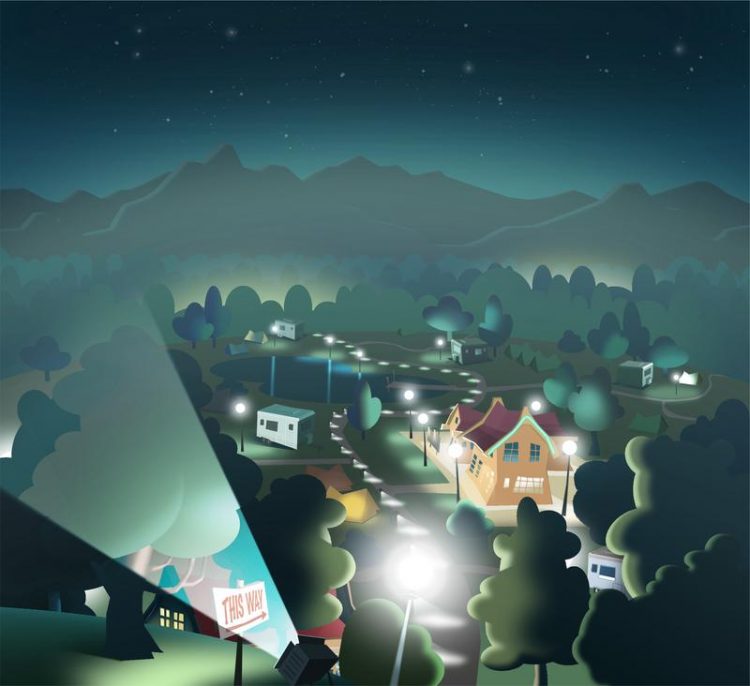Protect the Night: Research Network Publishes Recommendations for Exterior Lighting

Poor example of exterior lightning: The light shines into the sky, where it spreads quickly and illuminates entire landscapes. Graphic: Rainer Stock
“Light has effects,” says coordinator of the network Sibylle Schroer, “on plants and animals as well as on us humans.” Even small quantities of artificial light at the wrong time can disturb the inner clock, the release of hormones or even interfere with whole ecosystems. Predator-prey relations get mixed up, and nocturnal species increasingly lose their habitats. “In the long term, this can affect biodiversity,” says Sibylle Schroer who works as a scientist at the Leibniz-Institute of Freshwater Ecology and Inland Fisheries (IGB) in Berlin.
Nevertheless, we tend to illuminate our cities intensively – and light at night is increasing rather than decreasing, as scientists have been observing at a global scale for numerous years.
How this situation can be improved is outlined by practical recommendations for action, which the researchers have now published:
1) Avoid cold white light with wavelengths below 500 nanometres as far as possible: The trend towards cold white light in the form of LEDs and energy saving lamps is critically discussed by the scientists. The high proportion of short-wave blue light disturbs the circadian rhythms of higher vertebrates as well as humans. Chronic shifts can interfere with sleep, metabolism and immune defence, leading to serious health problems. Possible consequences are suppressed fat catabolism, diabetes or depression. Outdoor lighting should have therefore a colour temperature of 3000 Kelvin or lower recommend the researchers.
2) Use lampshades to direct the light where it is needed: Suitable lampshades do not allow the light to be seen directly. Properly directed light does not shine in the eyes of pedestrians, in windows or into the sky, where it spreads quickly and illuminates entire landscapes. Light – including façade lighting – should always shine downwards. For example, ground-recessed spotlights that radiate the light upwards should be avoided.
3) Illuminate streets with the lowest possible intensity: Rural roads should only be illuminated if absolutely necessary. Where needed, an average luminance of 0.3 candelas per square meter should not be exceeded, which typically corresponds to an illuminance of 4 lux. This complies with the lowest class of the EU standard for street lighting (EN13201). “EU standards recommend much brighter values than they are currently implemented in most municipalities,” reports Sibylle Schroer. Compliance with the standards across Europe could therefore lead to drastically higher energy consumption and CO2 emissions in road lighting.
4) Adapt exterior lighting to times of use. After 10 o'clock or after midnight, considerably less light is needed, such that street lights can be dimmed. A reduction of illumination levels by 50-80% is possible. “Private lighting should be turned off completely if there is no immediate need” recommends Sibylle Schroer.
All recommendations are available as illustrated flyers for citizens as well as for nature protection areas:
http://www.cost-lonne.eu/wp-content/uploads/2016/07/Flyer-1-general-outdoor-ligh…
http://www.cost-lonne.eu/wp-content/uploads/2016/07/Flyer-LoNNe-statement-NPA.pd…
The guidelines are the results of a four-year interdisciplinary cooperation of the “Loss of the Night Network” consisting of 67 active members from 16 different disciplines and 18 countries. It is supported by the European Cooperation for Science and Technology (EU-COST Action ES1204, 2012-2016). The network will continue to be active as an external team in the framework of the EU collective awareness platform for sustainable and social innovation STARS4ALL (www.stars4all.eu).
The flyers and further information are available at http://www.cost-lonne.eu
Contact:
Dr. Sibylle Schroer
Leibniz-Institute of Freshwater Ecology and Inland Fisheries (IGB)
Müggelseedamm 310, 12587 Berlin
schroer@igb-berlin.de
+49 (0)30 64 181 717
About IGB:
Work at IGB combines basic research with preventive research as a basis for the sustainable management of freshwaters. In the process, IGB explores the structure and function of aquatic ecosystems under near-natural conditions and under the effect of multiple stressors. Its key research activities include the long-term development of lakes, rivers and wetlands under rapidly changing global, regional and local environmental conditions, the development of coupled ecological and socio-economic models, the renaturation of ecosystems, and the biodiversity of aquatic habitats. Work is conducted in close cooperation with universities and research institutions from the Berlin/Brandenburg region as well as worldwide. IGB is a member of the Forschungsverbund Berlin e.V, an association of eight research institutes of natural sciences, life sciences and environmental sciences in Berlin. The institutes are members of the Leibniz Association.
Media Contact
All latest news from the category: Power and Electrical Engineering
This topic covers issues related to energy generation, conversion, transportation and consumption and how the industry is addressing the challenge of energy efficiency in general.
innovations-report provides in-depth and informative reports and articles on subjects ranging from wind energy, fuel cell technology, solar energy, geothermal energy, petroleum, gas, nuclear engineering, alternative energy and energy efficiency to fusion, hydrogen and superconductor technologies.
Newest articles

“Nanostitches” enable lighter and tougher composite materials
In research that may lead to next-generation airplanes and spacecraft, MIT engineers used carbon nanotubes to prevent cracking in multilayered composites. To save on fuel and reduce aircraft emissions, engineers…

Trash to treasure
Researchers turn metal waste into catalyst for hydrogen. Scientists have found a way to transform metal waste into a highly efficient catalyst to make hydrogen from water, a discovery that…

Real-time detection of infectious disease viruses
… by searching for molecular fingerprinting. A research team consisting of Professor Kyoung-Duck Park and Taeyoung Moon and Huitae Joo, PhD candidates, from the Department of Physics at Pohang University…





















